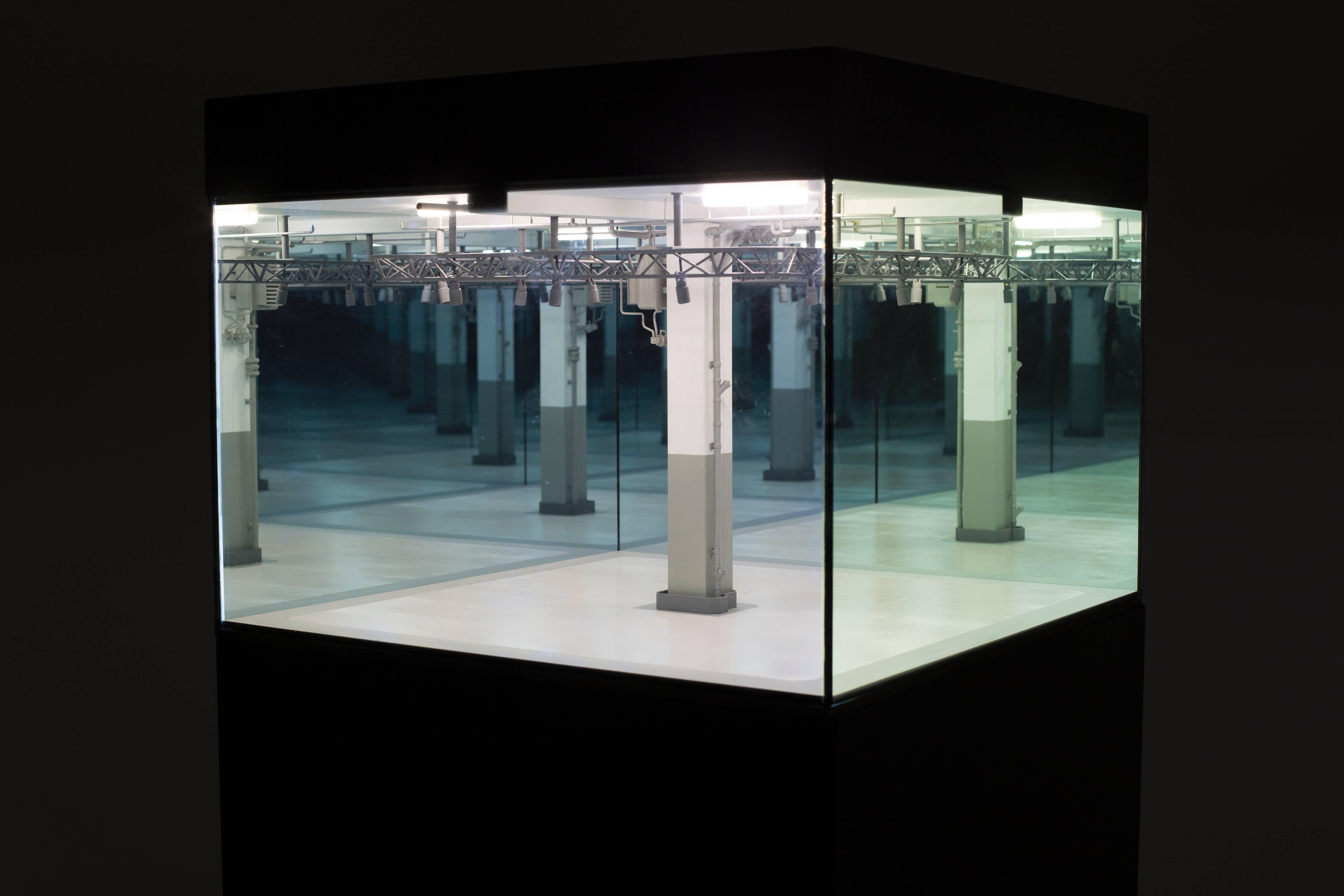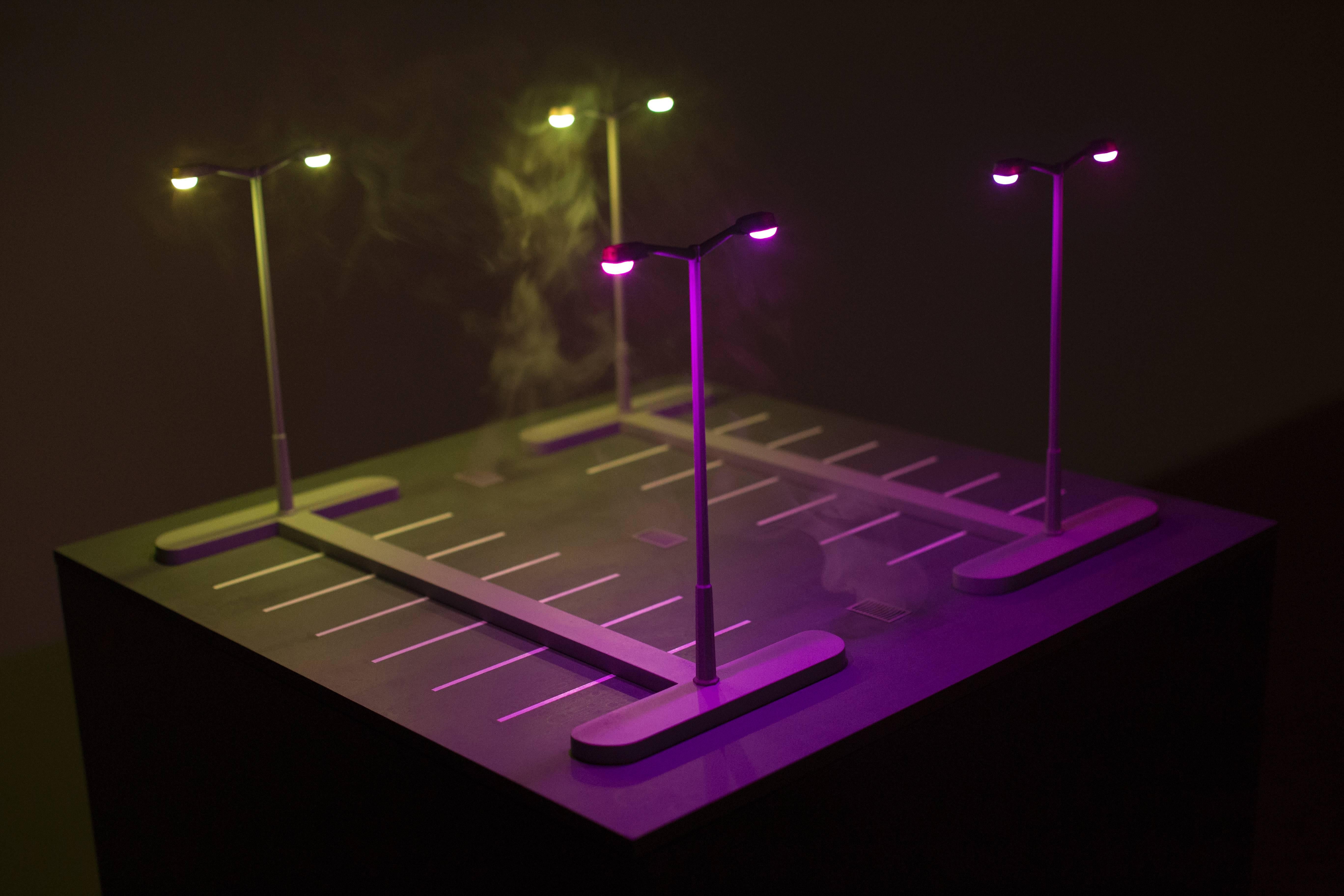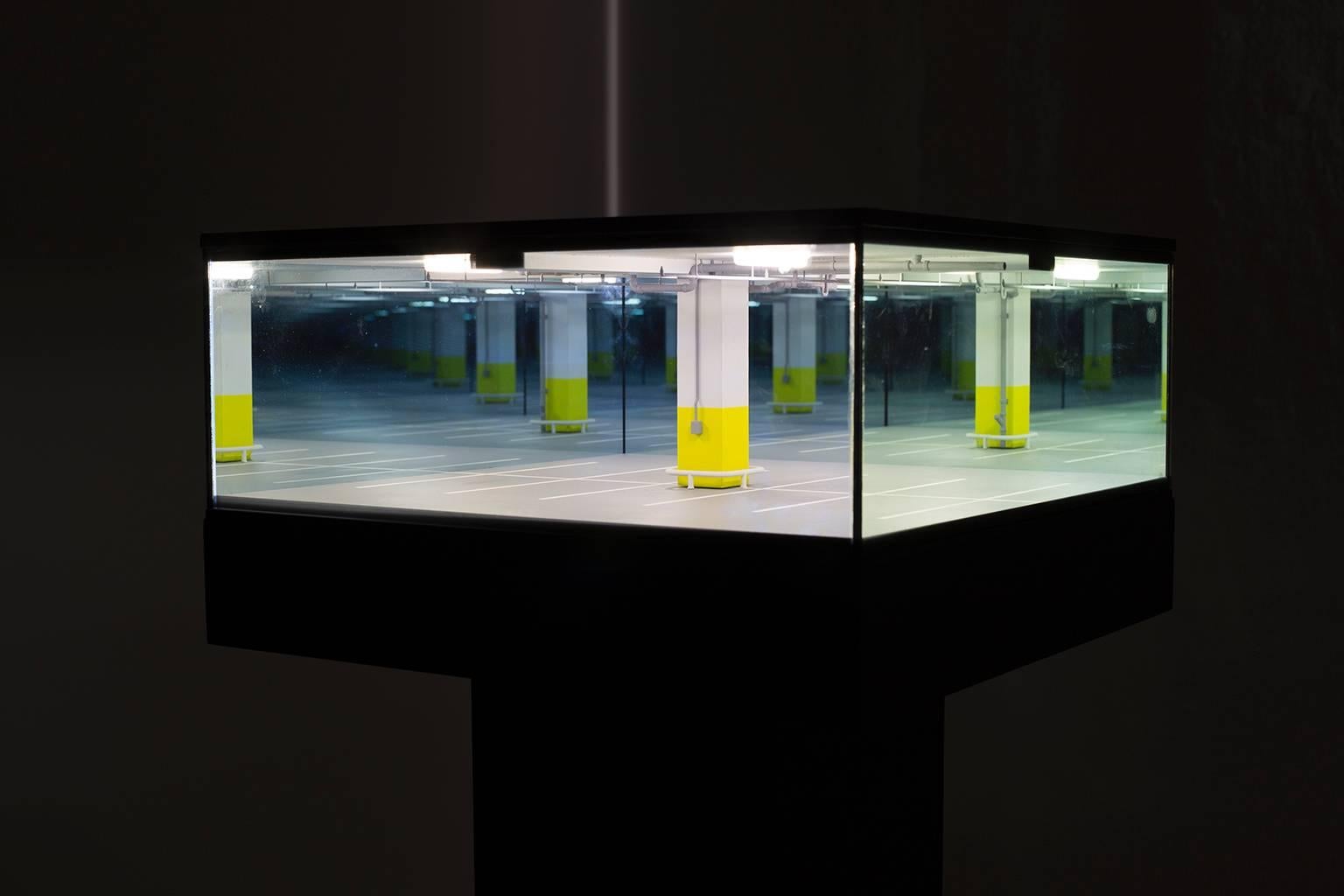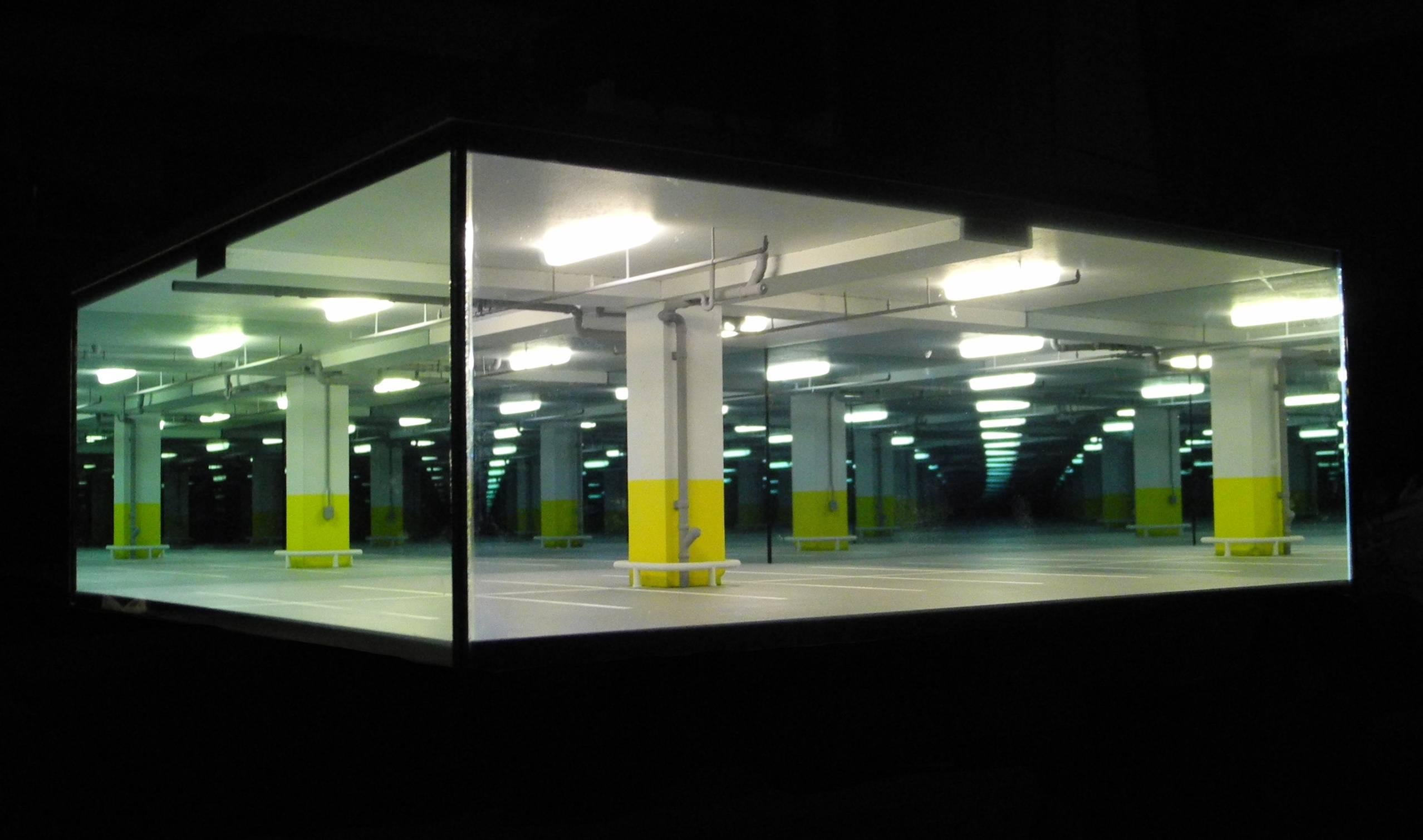Want more images or videos?
Request additional images or videos from the seller
1 of 5
Guillaume LachapelleThe Cell2013
2013
About the Item
The Architecture of Knowledge in the work of Guillaume Lachapelle
L. Sasha Gora
Jorge Luis Borges imagined the universe as a library, one “composed of an indefinite and perhaps infinite number of hexagonal galleries.” The bookshelves in Guillaume Lachapelle’s rigorously detailed, architectural miniatures are similar imaginings of knowledge, infinity, and the meaning of books.
When Lachapelle predominantly sculpted with wood, the library was already present in his work. Take for instance the delicate shelves in Maneges (2004-2006). In 2009, he began to employ 3D printing and since, he has drafted bookshelves as white, intricately printed sculptures. Fissure, 2009, a bookshelf whose centre collapses, like quicksand, into a void; Le piège, 2009, an isolated balcony that protrudes from a bookshelf; Évasion 2, 2011, a fragile staircase that leads to a corridor library. Despite their sculptural form, these pieces never feel static. They suggest something beyond the shelves. Books are often described as gateways to other worlds and the artist Dominique Gonzalez-Foerster exemplifies this literally. In her 2013 La Bibliothèque clandestine at Palais de Tokyo what at first appears to be a bookshelf is actually a rotating door that opens into a secret gallery.
For Lachapelle’s sixth solo exhibition at Art Mûr, Vision, we encounter again the library. This time, he employs single-sided mirrors to exaggerate a sense of the infinite, getting closer to Borges’ indefinite library, such as in Awaiting Knowledge (2013). We confront the same architecture in Metro (2013) and Last Night (2013). A library, a subway car and a hallway from the Titanic, respectively, all melt into an intriguing yet alarmingly dark void. Where does the darkness at the end of hall lead to? Lachapelle’s miniatures act as a threshold between what is seen and not seen.
Although a good five centuries apart, the printing press and 3D printing both belong to the history of print. However, in Lachapelle’s miniatures, books are separated from their use. We cannot read them. They are rendered decorative, almost fetishized, and so instead we must mediate on their symbolism. This requires imagination. Lachapelle’s models are far too tiny for us to occupy physically, and so we must occupy them with our imagination, as when we occupy books, turning the words into the stories and images of people and places.
In Borges’ story, what began as extravagant happiness - the Library of Babel housing all books and holding all of the world’s answers – turned to depression: “The certitude that some shelf in some hexagon held precious books and that these precious books were inaccessible, seemed almost intolerable.” For Lachapelle, books represent a similar anxiety: as much as we know, there is always more that we don’t.
Guillaume Lachapelle's artistic practice is shaped predominantly by sculpture, expressed in the form of installations and detailed miniature models. Lachapelle presents playful universes which combine objects of undetermined purpose; in this way, he opens the conventions of our reality to fresh disposition. The architecture of his models - which Lachapelle has recently begun to make with the help of the latest 3-D printing technology - shows motifs originating from the everyday, certainly, but seeming strange, alienating or even uncanny when combined as the artist chooses. A kind of transition between two worlds often appears in Lachapelle's work - for example when the model of a library filled with books curves inwards and reveals a mysterious opening pointing into darkness - these are the artist's references to spaces and occurrences which may be concealed below the surface of outward semblance.
Guillaume Lachapelle has participated in several solo and group exhibitions including Manèges at Circa - Centre d'Exposition Art Contemporain (Montreal) in 2006; Quebec Gold at the Ancien Collège des Jésuites (Rheims, France) in 2008 and in Abracadabra (Edward Day Gallery, Toronto) in 2008. Recently, he completed a permanent commemorative sculpture in Belmont Park (the site of an amusement park that operated between 1923 and 1983) located in the Ahuntsic-Cartierville neighbourhood of Montreal.
- Creator:Guillaume Lachapelle (1974, Canadian)
- Creation Year:2013
- Dimensions:Height: 12 in (30.48 cm)Width: 12 in (30.48 cm)Depth: 12 in (30.48 cm)
- Medium:
- Movement & Style:
- Period:
- Condition:
- Gallery Location:Montreal, CA
- Reference Number:1stDibs: LU476149074
About the Seller
5.0
Vetted Seller
These experienced sellers undergo a comprehensive evaluation by our team of in-house experts.
Established in 1996
1stDibs seller since 2014
96 sales on 1stDibs
- ShippingRetrieving quote...Ships From: Montreal, Canada
- Return PolicyA return for this item may be initiated within 7 days of delivery.
More From This SellerView All
- Night ShiftBy Guillaume LachapelleLocated in Montreal, QuebecText by Terence Sharpe There is a moment in Andrei Tarkovsky’s Solaris (1972) when the character Hari commits suicide by drinking liquid oxygen. As she is not actually a human, but an artificial hybrid product of the mysterious planet and the protagonists’ memories, she heals rapidly and is alive again minutes later. Her choice to take her own life is poignant, seemingly the action of a being becoming aware of its hopeless infinitude. Her realization that while the men will die on the space station or elsewhere, her existence is that of immortality, a deeply alienating notion that causes her to seek her own destruction. The Montreal artist Guillaume Lachapelle has one work that prompts a sense of eternal alienation that echoes Hari’s tragedy. The work greets the viewer with a empty doorway flanked by clinically white bookshelves...Category
2010s Contemporary Figurative Sculptures
MaterialsNylon, Glass, Wood, LED Light, Acrylic
- Night shift IIBy Guillaume LachapelleLocated in Montreal, QuebecText by Terence Sharpe There is a moment in Andrei Tarkovsky’s Solaris (1972) when the character Hari commits suicide by drinking liquid oxygen. As she is not actually a human, but an artificial hybrid product of the mysterious planet and the protagonists’ memories, she heals rapidly and is alive again minutes later. Her choice to take her own life is poignant, seemingly the action of a being becoming aware of its hopeless infinitude. Her realization that while the men will die on the space station or elsewhere, her existence is that of immortality, a deeply alienating notion that causes her to seek her own destruction. The Montreal artist Guillaume Lachapelle has one work that prompts a sense of eternal alienation that echoes Hari’s tragedy. The work greets the viewer with a empty doorway flanked by clinically white bookshelves...Category
2010s Contemporary Figurative Sculptures
MaterialsNylon, Glass, LED Light, Acrylic
- UntitledBy Guillaume LachapelleLocated in Montreal, QuebecText by Terence Sharpe There is a moment in Andrei Tarkovsky’s Solaris (1972) when the character Hari commits suicide by drinking liquid oxygen. As she is not actually a human, but an artificial hybrid product of the mysterious planet and the protagonists’ memories, she heals rapidly and is alive again minutes later. Her choice to take her own life is poignant, seemingly the action of a being becoming aware of its hopeless infinitude. Her realization that while the men will die on the space station or elsewhere, her existence is that of immortality, a deeply alienating notion that causes her to seek her own destruction. The Montreal artist Guillaume Lachapelle has one work that prompts a sense of eternal alienation that echoes Hari’s tragedy. The work greets the viewer with a empty doorway flanked by clinically white bookshelves...Category
2010s Contemporary Figurative Sculptures
MaterialsNylon, Glass, Wood, LED Light
- UntitledBy Guillaume LachapelleLocated in Montreal, QuebecGuillaume Lachapelle's artistic practice is shaped predominantly by sculpture, expressed in the form of installations and detailed miniature models. Lachapelle presents playful unive...Category
21st Century and Contemporary Contemporary Sculptures
MaterialsNylon, Glass, Mirror, Wood, LED Light
- Nuit étoiléeBy Guillaume LachapelleLocated in Montreal, QuebecGuillaume Lachapelle's artistic practice is shaped predominantly by sculpture, expressed in the form of installations and detailed miniature models. Lachapelle presents playful unive...Category
21st Century and Contemporary Contemporary Sculptures
MaterialsNylon, Glass, LED Light
- CarrouselBy Guillaume LachapelleLocated in Montreal, QuebecGuillaume Lachapelle's artistic practice is shaped predominantly by sculpture, expressed in the form of installations and detailed miniature models. Lachapelle presents playful universes which combine objects of undetermined purpose; in this way, he opens the conventions of our reality to fresh disposition. The architecture of his models - which Lachapelle has recently begun to make with the help of the latest 3-D printing technology - shows motifs originating from the everyday, certainly, but seeming strange, alienating or even uncanny when combined as the artist chooses. A kind of transition between two worlds often appears in Lachapelle's work - for example when the model of a library filled with books curves inwards and reveals a mysterious opening pointing into darkness - these are the artist's references to spaces and occurrences which may be concealed below the surface of outward semblance. Guillaume Lachapelle has participated in several solo and group exhibitions including Manèges at Circa - Centre d'Exposition Art Contemporain (Montreal) in 2006; Quebec Gold at the Ancien Collège des Jésuites (Rheims, France) in 2008 and in Abracadabra (Edward Day...Category
21st Century and Contemporary Post-Modern Sculptures
MaterialsNylon
You May Also Like
- HannoverBy Jesús Rafael SotoLocated in Miami, FLJesus Rafael Soto "Hannover" 1970 Color silkscreen on transparent plexiglass panel, metal rods on nylon threads. It has the original box. 7 x 21 x 5 in Ed. 170 of 200 Provenance: Va...Category
1970s Kinetic Abstract Sculptures
MaterialsMetal
- Complete Set of 2 Kachamukku Authentic KAWS Art SculpturesBy KAWSLocated in Draper, UTKAWS teamed up with Hirake! Ponkikki’s Gachapin and Mukku for the release of his Kachamukku figures. KAWS KACHAMUKKU figures released in a green and re...Category
2010s Abstract Sculptures
MaterialsNylon, Plastic, Vinyl
- Yayoi Kusama Plush Pumpkin (Yellow and black pumpkin)By Yayoi KusamaLocated in Central, HKYayoi Kusama Pumpkin Plush Yellow (Small), 2004 Nylon 6 x 9 2/5 in diameter 15.24 x 24 cm diameterCategory
2010s Figurative Sculptures
MaterialsNylon, Polyester
- Yayoi Kusama Set of 2 Small Plush Pumpkin (Red White and Yellow Black))By Yayoi KusamaLocated in Central, HKYayoi Kusama Large Set of 2 Pumpkin Plush Yellow and Black & Red and White, 2004 Polyester, Nylon 6 × 9 9/20 × 9 9/20 in 15.2 × 24 × 24 cm (each)Category
2010s Figurative Sculptures
MaterialsNylon, Polyester
- Yayoi Kusama Plush Pumpkin (Yellow and black pumpkin)By Yayoi KusamaLocated in Central, HKYayoi Kusama Pumpkin Plush Yellow (Small), 2004 Nylon 6 x 9 2/5 in diameter 15.24 x 24 cm diameterCategory
2010s Figurative Sculptures
MaterialsNylon, Polyester
- Yayoi Kusama Pumpkin Mascot (Yellow and black pumpkin)By Yayoi KusamaLocated in Central, HKYayoi Kusama Yellow Pumpkin Mascot (Yellow and black), 2019 Parachute Nylon 3 x 3 9/10 x 3 9/10 in 7.5 × 10 × 10 cmCategory
2010s Figurative Sculptures
MaterialsNylon, Polyester
Recently Viewed
View AllMore Ways To Browse
The Used Drafting
Light Sculpture Led
Dark Blue Sculpture
The Secret Door
Hexagon Modern Art
Cell Light
Celling Light
Bookshelf Art
Infinity Mirror Art
Hexagon Sculpture
Staircase Light
Palais De Tokyo
Bookshelf Sculpture
Miniature Car
Infinity Mirror Light
Bookshelf With Door
Led Gold Mirror
Light Art Infinity Mirror





